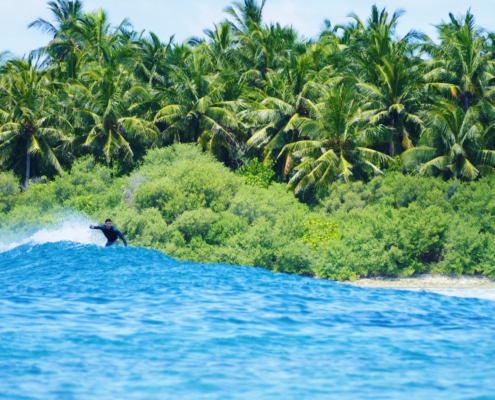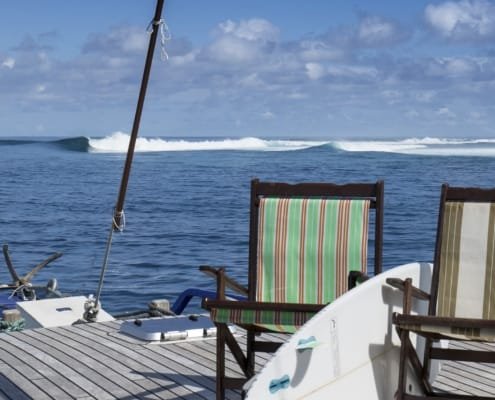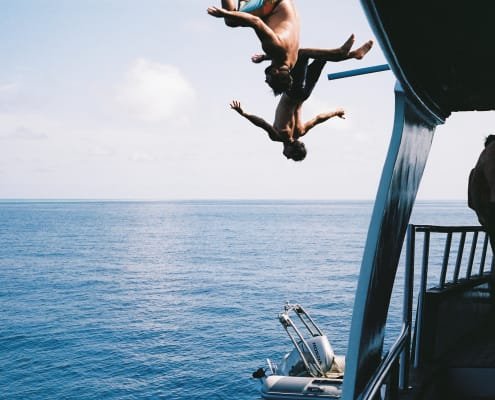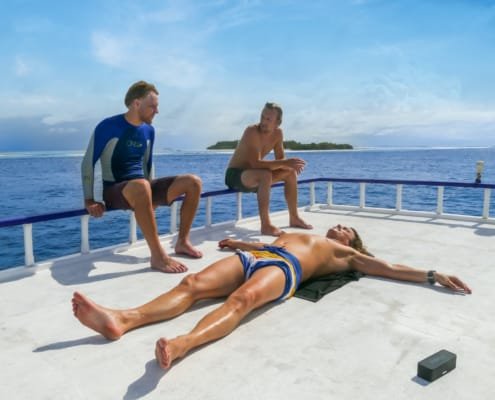10 REASONS WHY THE MALDIVES SHOULD BE YOUR NEXT SURF TRIP
WHY THE MALDIVES?
The Maldives have been on surfers’ bucket-lists ever since Tony Hussain accidentally discovered waves there, when his boat washed ashore nearly 50 years ago, and for good reason. This collection of over 1200 islands is widely regarded as one of the best places to surf in the world. Think tropical palm-fringed lineups, abundant sea life, and super-consistent waves with something for every level of surfer.
Read on for our top 10 reasons why we believe The Maldives should be your next surf trip…

Coach Mark Boyd with off-the-top number 1384 of the trip
1. ONE OF THE MOST CONSISTENT SURF DESTINATIONS ON THE PLANET
Ever been on a surf trip and been left disappointed by a lack of swell? We know the feeling. Fortunately, being positioned in the middle of the Indian Ocean means The Maldives is one of the most consistent surf zones in the world.
As with all Indian Ocean destinations, SW swells regularly light up the region between April and October. These powerful, long-period swells wrap into south facing shores in far-flung atolls – often with nobody around.
However, it’s the lesser known SE swells that really make the Maldives so consistent and unique. These swells are created by the SE trade winds that blow across much of Indonesia between April and October. If you’ve ever been in Indo at this time, you will know these winds blow every single day. This means there is a constant stream of SE swell being sent towards the Maldives, ready to be groomed by westerly trade-winds on arrival.
We’ve even scored pumping waves at unknown reef passes during rare west swells!
This exposure to swell is a key reason why The Maldives is one of the best places to surf in the world. Magicseaweed data (R.I.P) shows that the Maldives has a swell consistency of between 95 and 99% between April and October – quite incredible! Make the most of these swells and join one of our signature coaching trips where we scour the whole of the Atolls looking for the most suitable conditions.

2. THE MOST BEAUTIFUL LINEUPS ON EARTH
Picture yourself pulling up to an uninhabited tropical island. Densely packed with lush, green palm trees. Bath-warm, gin-clear water laps against the coral and an approaching set sounds like tearing paper as it peels, unadulterated, down the barrier reef beyond the lagoon. The sheer beauty of some of the breaks needs to be seen to be believed.
The beauty isn’t just above the surface… You’ll be sharing some of the clearest water on the planet with resident dolphins, turtles, manta rays, tropical fish and reef sharks. There’s more to a dream Maldives session than the perfect waves.

3. ACCESSIBLE, EASY TRAVEL
Compared to many tropical surf destinations, travelling to the Maldives is a breeze – especially for us Europeans. There are direct flights from major European hubs, although most will have a short transit through the Middle East. It’s about the same for those coming from Australasia, only with Kuala Lumpur and Singapore serving as the most common stopovers.
Those coming from the U.S. have a longer journey ahead, but it’s still relatively straightforward and often doable with just one layover.
The convenience continues once you land in The Maldives. Male International airport (Velana) is situated right next to the ocean, meaning no lengthy transfer in a cramped van with broken AC. Simply stroll 30 meters outside the arrivals hall, meet your guide, and jump on your floating home. In some cases, you can be surfing within 2 hours of touching down. Most arrivals land in the morning, meaning we can usually get a quick session in before lunch is even served – something that’s almost impossible to do in other destinations.
Last but not least, no visa is required for tourism in The Maldives. You are granted 30-days on arrival which can be extended for another 30-days with relative ease. Hassle-free surf trips are the best surf trips.

Was this the best surf we scored all year? No. Did the adventure and novelty of surfing an unknown wave alone make it one of the most special sessions? Absolutely.
4. EMPTY LINEUPS STILL POSSIBLE
A quick flick through of our Instagram and you may think our captions are false. The number of times we surfed alone in 2022 feels almost unfair. Particularly in a world where lineups are becoming more and more crowded. We scored a load of empty sessions on our Advanced Coaching Trip back in April of this year, too.
The Maldives aren’t empty, however. Far from it. But we are willing to go the extra mile (or hundred) to ensure the best chance of surfing with minimal crowds. It’s not always possible, but we estimate that 50% of sessions last season were solo. There are a huge number of waves in The Maldives and the distance from the well-known waves of Male to the far south of the Central Atolls is vast – almost a 24hr cruise. Unlike some other charters who have a fixed route, our itineraries are solely based around the conditions and crowds.
Running coaching trips demands that we are surfing relatively quiet waves. So if spot A is a 9/10 but busy, and spot B is a 7/10 but empty, we’ll be heading to spot B. Especially when a 7/10 day in the ‘dives equates to an 11/10 at your local.
We’re highly experienced when it comes to searching for surf in The Maldives. In August 2022, whilst 5 boats battled it out in pumping surf at Spot X, we spotted a rare Westerly swell and nipped a few hours south. We scored the wave above without another soul for miles, before nipping across the channel and scoring the cranking right on the other side. Surfing nirvana.

5. THE PERFECT PLACE FOR A BOAT TRIP
With the Maldives being 95% ocean, it stands to reason that the best way to get around is by boat. If you’re lucky enough to have been on a surf charter before you’ll know just how special they are. With a good guide in charge you can sit back, relax, and enjoy the spectacular scenery as we take you from perfect surf spot to perfect surf spot. When surfing the best waves possible is the priority, a boat trip cannot be beaten. You can read an extended blog post on why we think so here.
With that said, in our opinion The Maldives is the best place in the world for a surf charter. Most of the waves here break off uninhabited or sparsely populated islands and often a few hundred metres offshore. This means that even if you put all your eggs in one basket and stayed on one of these islands – crossing everything that the conditions aligned for that particular wave – accessing it can be a bit of a mission.
On the contrary, entering the lineup from a surf charter couldn’t be easier. Simply jump in the dhingy at the back of the boat and get dropped off a stones-throw from the peak; no duck dives or scrambles over the sharp reef. When you’re done, wave your board in the air and the dhingy captain will collect you from the channel. It almost sounds too good to be true!
6. USER FRIENDLY LINEUPS
We hate to break it to you, but those perfect tubes in every Mentawai edit are probably beyond your pay grade. Whilst it looks like absolute perfection on your 5″ iphone screen , the reality of a double overhead wave throwing top to bottom is very consequential. Dry inside-sections, impossible walk-outs over the reef, and hungry packs of Aussie and Brazilian pros makes the whole experience quite intense, to say the least.
Enter, The Maldives. Don’t get us wrong, the Maldives does have it’s share of heavier, barreling waves. From Cokes in the north, to Finnamas in the Central Atolls, all the way to the Beacons in the far South. Fortunately, for us average Joe’s there are plenty of user-friendly waves in-between. Most of these break into deeper water rather than shutting down on a shallow end section. Think ‘4-5 turns then kick out into the channel’, not ‘hold-on-for-your-life before an inevitable scraping across the reef’.

7. NO MOSQUITOS OR DANGEROUS WILDLIFE
After some of the points above this one seems almost a little trivial. Can a lack of mosquitos really have a meaningful impact on the Maldives being the best surf destination on earth? Yes. Yes it can.
If you’ve ever spent time at land camps in any tropical destination you’ll know just how much of a negative impact the mozzies, scorpions, and other tropical nasties can have – from mild itching to severe bites and insomnia.
Fortunately, being at sea means we’re typically away from all of these annoyances.
There’s not much to worry about from below either. You’ll occasionally see reef sharks zig-zagging their way across the reef, but these guys don’t pose any threat to surfers and are an incredible sight to see. On some trips we’re even lucky enough to snorkel wit Nurse Sharks – always an unforgettable experience!

8. LONG SEASON WITH VARYING CONDITIONS
The surf season in The Maldives is generally considered to be from April-October. That said, differing wind patterns in the Southern Atolls means that you can score perfect waves all year round.
As a brief summary, here’s our suggestion:
Off season (late October to early March) – head to the Southern Atolls, for clean, empty lineups and powerful waves.
Shoulder season (March/April & September/October) – light winds and consistent swells in the Central Atolls
Peak season (May – September) – consistent, solid SE swells and WSW trade winds make the Malé Atolls or east facing Central Atolls light up
See our full breakdown of the Maldives Surf Season and regions here.

9. TROPICAL CLIMATE
Unsurprisingly, given its proximity to the equator, predicting the temperature during your stay in The Maldives won’t be hard. It hovers consistently between 27-31c.
You can leave your wetsuit at home too, with water temperatures never dropping below 27c. We recommend bringing a long-sleeve surf top and a hat to protect yourself from the sun. Those of you who are particularly sun sensitive should look into a pair of lycra bottoms or ‘surf-tights’ too. 27-31c doesn’t sound THAT hot- but it feels way hotter than this in reality and the sun can be brutally strong.

10. 3 DISTINCTLY DIFFERENT AND WAVE-RICH REGIONS
As mentioned above, The Maldives caters for every level of surfer. It’s one of the few destinations where a ‘just surfing green waves’ intermediate can have just as fun as a ‘been surfing all my life’ tube pig. This is down to the variety of the surf spots and the variation across the different regions.
In the north are the Malé Atolls, with Male Airport sitting right inbetween the waves North and South Malé Atoll. Malé Atolls are home to the most well-known Maldivian waves and some of the best waves in the country. However, it’s consistency, quality and proximity to the airport means they’re often crowded.
Keep cruising 8-24hrs south and you’ll reach Meemu, Dhaalu, Thaa and Laamu Atolls – collectively part of the Central Atolls. This is where the majority of our coaching trips take place due it’s ability to deal with all swell and wind directions, and thin crowd factor.
Another long sail (or short flight) south, and you’ll reach the Southern Atolls. They’re widely considered one of surfing’s last frontiers thanks to their isolation and remoteness. It’s home to a number of epic set-ups, including some of the heaviest and hollowest waves in the country. We usually begin our season here in March.




